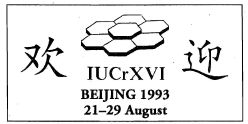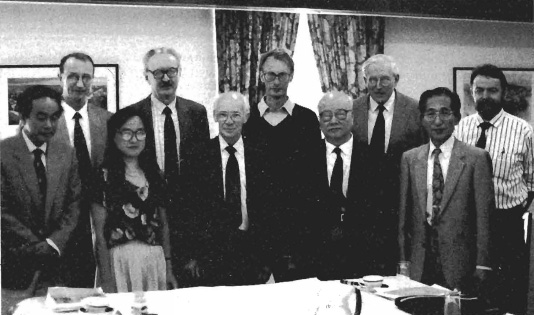
IUCr Congress
XVI Congress and General Assembly of the IUCr
 The XVI Congress and General Assembly of the IUCr will be held Aug. 21-29, 1993 at the Beijing International Convention Center (BICC) at the invitation of the Chinese National Committee for Crystallography and the China Association for Science and Technology. The BICC, which was designed for international conferences, includes a comprehensive conference building, a dining hall, a four-star hotel (Continental Grand Hotel), recreation facilities, a shopping center, and restaurants. The Conference Mansion has a grand conference hall that will accommodate 2,800 people, two theater-style auditoriums that will seat 596 and 170, and two dozen meeting rooms of various sizes. The center is completely air-conditioned and equipped with all the necessary audio-visual equipment. The spacious high-ceilinged exhibit and poster hall is in the same building with all of the lecture halls and conference rooms. Fully air-conditioned, modern high-rise hotels and apartment buildings surround the convention center. The rates quoted for the meeting are US $27-$37 per person per night for a double occupancy hotel room, US $50-$70 per person per night for a single room, and US $12 per person per night for a double occupancy student room. The BICC is located on bus lines 9-km north of the Forbidden City, 11-km north of the railway station, and 20-km west of the International Airport.
The XVI Congress and General Assembly of the IUCr will be held Aug. 21-29, 1993 at the Beijing International Convention Center (BICC) at the invitation of the Chinese National Committee for Crystallography and the China Association for Science and Technology. The BICC, which was designed for international conferences, includes a comprehensive conference building, a dining hall, a four-star hotel (Continental Grand Hotel), recreation facilities, a shopping center, and restaurants. The Conference Mansion has a grand conference hall that will accommodate 2,800 people, two theater-style auditoriums that will seat 596 and 170, and two dozen meeting rooms of various sizes. The center is completely air-conditioned and equipped with all the necessary audio-visual equipment. The spacious high-ceilinged exhibit and poster hall is in the same building with all of the lecture halls and conference rooms. Fully air-conditioned, modern high-rise hotels and apartment buildings surround the convention center. The rates quoted for the meeting are US $27-$37 per person per night for a double occupancy hotel room, US $50-$70 per person per night for a single room, and US $12 per person per night for a double occupancy student room. The BICC is located on bus lines 9-km north of the Forbidden City, 11-km north of the railway station, and 20-km west of the International Airport.
Registration, the Opening Ceremony, and the presentation of the third Ewald Prize will take place on Saturday, Aug. 21. The closing session will be held on Sunday, Aug. 29. There will be six and one-half days of scientific sessions, a full day's excursion on Friday, Aug. 27, and a feast that evening. Four evenings are reserved for the activities of the General Assembly.
The Program Committee met in Pittsburgh, PA, USA. Aug. 3-5, 1992, to review over 60 proposals for plenary lecture topics and speakers and 150 proposals for microsymposia and open commission meetings in 21 categories. The program approved by the Executive Committee of the IUCr has 18 main lectures, 42 microsymposia sessions, and 12 discussion sessions. There will be 6 concurrent microsymposia in the morning and 4 concurrent discussion sessions in the afternoons. If possible all posters will be displayed for a full 6 days. Most of the contributed papers will be presented in poster sessions. Discussion sessions following poster sessions will be organized in certain cases. X.-j. Xu is Chair of the Program Committee and M.-c. Shao is Chair of the Organizing Committee. The deadline for abstract submission is Feb. 1, 1993. Requests for additional information should be sent to: X.-l. Jin, Dept. of Chemistry, Peking University, Beijing 100871, China.
Preliminary scientific program
The Ewald Medal will be presented during the Opening Ceremony followed by the Ewald Award lecture.
 Members of the Program Committee for the XVI Congress and General Assembly of the IUCr: Front row: X. Xu; L.-h. Lal; F. Liebau; Y. Tang; Y. Katsube. Back row: J. R. Helliwell; V. I. Simonov; W. G. J. Hol; J. W. White; and Y. Le Page; not shown A. Authier and W. L. Duax.
Members of the Program Committee for the XVI Congress and General Assembly of the IUCr: Front row: X. Xu; L.-h. Lal; F. Liebau; Y. Tang; Y. Katsube. Back row: J. R. Helliwell; V. I. Simonov; W. G. J. Hol; J. W. White; and Y. Le Page; not shown A. Authier and W. L. Duax.
Plenary lecture topics and speakers will be: Fullerenes (W. I. F. David); Time Resolved Macromolecular Crystallography (J. K. Moffat); Crystal Structure and Superconducting Transition of High Tc Materials (V. N. Molchanov); Structure Based Drug Design (L. N. Johnson); Recognition in Supramolecular Structures (W. H. E. Saenger); Decagonal Quasicrystal and Crystalline Approximates (K.-h. Kuo); Virus Structure and Virus Infectivity (M. G. Rossmann); Crystallography in Biotechnology (T. A. Blundell); Internal Surfaces as Order Principles in Solids (R. F. Nesper); Towards the Structure of the Ribosome (A. Yonath); Direct and Patterson Methods for Macromolecular Structure Determination (H.-f. Fan); Computer Simulation of Inorganic Structures with First-Principle Interatomic Potentials (S. Tsuneyuki); Crystallographic Environment as an Approach to Biological Macromolecular Recognition and Drug Design (C. Pascard); Neutron and X-ray Reflectometry of Surfaces and Interfaces (R. K. Thomas); Third Generation X-ray Synchrotrons - First Experiments from ESRF (J. Als-Nielsen); Systematics of Crystal Packing in Molecular Solids (C. P. Brock); Microtomography (U. Bonse); The Contribution of Crystallography to the Elucidation of Hydrolytic Enzyme Mechanisms (M. N. G. James).
Microsymposia (MS) and Open Commission Meetings (OCM)
Each session will consist of invited papers selected by a Topic Chairperson, some of them being chosen from the contributed abstracts. Open Commission Meetings are microsymposia organized by the Commissions of the Union.
 Map of China with sites of IUCr and Satellite Meetings noted. A visit to the Great Wall of China will be a part of the all day excursion on Aug. 27, 1993.
Map of China with sites of IUCr and Satellite Meetings noted. A visit to the Great Wall of China will be a part of the all day excursion on Aug. 27, 1993.
01-Instrumentation and Experimental Techniques (X-ray, Neutrons, Electrons)
- MS-01.1
- Time Resolved Structural Studies
- MS-01.2
- Synchrotron Data Collection for Macromolecules
- OCM-01.3
- Area Detectors
- MS-01.4
- Magnetic Scattering
- MS-01.5
- X-ray and Neutron Powder Diffraction
- OCM-01.6
- Commission on Neutron Diffraction
02-Methods for Structure Determination and Analysis, Computing, and Graphics
- MS-02.1
- Direct Methods of Phasing Macromolecules
- MS-02.2
- Anomalous Dispersion Methods
- MS-02.3
- Strategies for Ab Initio Structure Determination from Powder Data
- MS-02.4
- Direct Phasing from Electron Diffraction Data for Crystal Structure Analysis
- MS-02.5
- Diffuse Scattering
- MS-02.6
- Computer Graphics in Crystallography
- MS-02.7
- Phasing and Refinement of Macromolecular Structures
- OCM-02.8
- Crystallographic Computing
03-Crystallography of Biological Macromolecules
- MS-03.1
- Nucleic Acid-Protein Interactions
- MS-03.2
- Viruses
- MS-03.3
- Receptors and Signal Transducing Proteins
- MS-03.4
- Metalloproteins
- MS-03.5
- Enzymes
- MS-03.6
- Protein-Saccharide Interaction
- DS-03.7
- Macromolecular Structures
- DS-03.8
- Hot Structures
04-Crystallography of Biological Small Molecules
- MS-04.1
- Molecular Structure and Biological Activity
- MS-04.2
- Structure of Nucleic Acids and Nucleic Acid Complexes
- OCM-04.3
- Commission on Small Molecules
05-Molecular Modeling and Design for Proteins and Drugs
- MS-05.1
- Protein Structure Prediction and Design
- DS-05.2
- HIV Proteins and Drug Design
- DS-05.3
- Proteins of Medical Interest and Their Interactions with Drugs
06-Crystallography of Organic Compounds
- MS-06.1
- Molecular Interactions in Organic Crystals
07-Crystallography of Organometallic and Coordination Compounds
- MS-07.1
- Molecular Recognition and Inclusion Compounds
08-Inorganic and Mineralogical Crystallography
- MS-08.1
- Inorganic Crystal Chemistry
- MS-08.2
- The Crystallography of Zeolites and Other Porous Materials
09-Engineering and Computer Simulation of Inorganic Crystal Structures
- MS-09.1
- Computer Simulation of Inorganic Crystal Structures
10-Physical and Chemical Properties of Materials in Relation to Structure (Superconductors, Fullerenes, etc.)
- MS-10.1
- Superconducting Materials
- MS-I0.2
- Fullerenes
11-Surfaces, Interfaces, and Thin Films
- MS-11.1
- Surface/Interface Structures
- MS-11.2
- Thin Film Structures
12-Amorphous, Imperfectly Ordered, and Quasiperiodic Materials
- OCM-12.1
- Quasicrystals and Incommensurate Crystal Structures
- DS-12.2
- Disordered Materials
- DS-12.3
- Glasses and Polymers
13-Defects, Microstructures, and Textures
- MS-13.1
- Electron Microscopy of Defects, Microstructures, and Textures
- MS-13.2
- Characterization of Materials by Topography and High Resolution Diffractometry
14-Diffraction Physics and Optics
- MS-14.1
- X-ray Optics for Synchrotron Radiation
- OCM-14.2
- Electron Densities at the Forefront of Chemistry and Solid State Physics
15-Crystal Growth
- MS-15.1
- Crystallization of Biological Macromolecules
16-Molecular Structure Determination by Methods Other Than Diffraction
- MS-16.1
- NMR/EXAFS/XANES
17-Symmetry and its Generalizations
- MS-17.1
- Incommensurate Symmetry and Properties
I8-Databases and Communications
- MS-18.1
- Crystallographic Databases
- OCM-18.2
- Journals
- DS-18.3
- Electronic Distribution of Information
19-Crystallographic Teaching and the History of Crystallography
- OCM-19.1
- Crystallographic Teaching
20-Industrial Crystallography
- MS-20.1
- Structure-Based Drug Design
- MS-20.2
- Aspects of Industrial Crystallography
- DS-20.3
- Multiphase Analysis
21-Crystallography at Nonambient Temperatures and/or Pressures: Phase Transitions
- MS-21.1
- Structure Analysis at High Pressures/High Temperatures
- MS-21.2
- Low Temperature Crystallography
- MS-21.3
- Phase Transitions in Crystals



